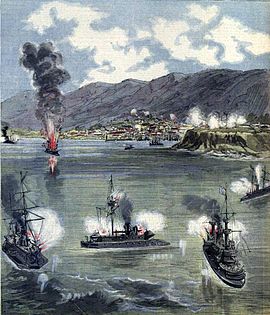This article includes a list of general references, but it lacks sufficient corresponding inline citations. (April 2022) |
| Chilean Civil War | |||||||
|---|---|---|---|---|---|---|---|
 Picture of the rebel fleet attacking Valparaíso, late August 1891, published in Le Petit Journal. | |||||||
| |||||||
| Belligerents | |||||||
|
|
| ||||||
| Commanders and leaders | |||||||
|
José Manuel Balmaceda † Orozimbo Barbosa † José Miguel Alcérreca † José Velásquez Bórquez Eulogio Robles Pinochet † |
Jorge Montt Adolfo Holley Estanislao del Canto Emil Körner | ||||||
| Strength | |||||||
|
40,000 2 torpedo boats |
~10,000 1 monitor 1 armoured frigate 1 cruiser 1 corvette 1 battery ship (January 1891) | ||||||
| Casualties and losses | |||||||
| 1 armoured frigate | |||||||
| 5,000[1] | |||||||
The Chilean Civil War of 1891 (also known as Revolution of 1891) was a civil war in Chile fought between forces supporting Congress and forces supporting the President, José Manuel Balmaceda from 16 January 1891 to 18 September 1891. The war saw a confrontation between the Chilean Army and the Chilean Navy, siding with the president and the congress, respectively. This conflict ended with the defeat of the Chilean Army and the presidential forces, and with President Balmaceda committing suicide as a consequence of the defeat.[2] In Chilean historiography the war marks the end of the Liberal Republic and the beginning of the Parliamentary Era.
